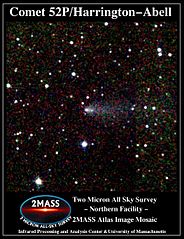52P/Harrington-Abell
 Kometa 52P/Harrington-Abell | |
| Odkrywca | Robert G. Harrington, George Ogden Abell |
|---|---|
| Data odkrycia | 22 marca 1955 |
| Nazwy alternatywne | 52P/1955 F1, 1954 XIII, 1955a, 52P/1962 B1, 1962 II, 1962a, 1969 III, 1968i, 1976 VIII, 1975l, 1983 XVII, 1983r, 1991 X, 1990m |
| Elementy orbity | |
| Półoś wielka | 3,8578 au |
| Mimośród | 0,5404 |
| Peryhelium | 1,7731 au |
| Aphelium | 5,9426 au |
| Okres orbitalny | 7,58 lat |
| Nachylenie orbity względem ekliptyki | 10,2316° |
| Długość węzła wstępującego | 336,8516° |
| Argument peryhelium | 139,5984° |
| Moment przejścia przez peryhelium | 7 marca 2014 |
| Charakterystyka fizyczna jądra | |
| Średnica | 2,6 km |
52P/Harrington-Abell – kometa krótkookresowa, należąca do rodziny Jowisza.
Odkrycie
Kometa tę odkryli Robert G. Harrington i George Ogden Abell 22 marca 1955 roku w Obserwatorium Palomar w Kalifornii.
Orbita komety
Orbita komety 52P/Harrington-Abell ma kształt elipsy o mimośrodzie 0,54. Jej peryhelium znajduje się w odległości 1,77 j.a., aphelium zaś 5,94 j.a. od Słońca. Jej okres obiegu wokół Słońca wynosi 7,58 roku, nachylenie do ekliptyki to wartość 10,2˚.
Właściwości fizyczne
Średnica jądra komety 52P/Harrington-Abell wynosi 2,6 km.
Zobacz też
Bibliografia
- 52P/Harrington-Abell w bazie Jet Propulsion Laboratory (ang.)
- 52P/Harrington-Abell w bazie Minor Planet Center (ang.)
Linki zewnętrzne
Media użyte na tej stronie
Atlas Image mosaic of comet 52P/Harrington-Abell, which was serendipitously observed by 2MASS on 1998 Oct 8 UT and is among twenty comets included in the 2MASS Second Incremental Data Release. Comets, of course, are within our Solar System and orbit the Sun, and therefore do not move sidereally (that is, as the stars do). Astronomers, however, have determined the ephemerides, or orbital parameters, for large numbers of known comets, so their positions in the sky along their orbits can be accurately predicted. Occasionally, comets, asteroids, and even planets can "accidentally" wander into the Survey. Comets reflect sunlight, yet near-infrared photometry can provide useful compositional and structural information about these objects. This comet was seen optically to experience a significant outburst in 1998 July (IAUC 6975) and became unusually bright by August (IAUC 6994), exceeding visual magnitude 11 by 1999 February (IAUC 7113). Its coma diameter was 1-2´ and tail length of about 2´ in 1998 (IAUC 6975). In 2001 December the comet was seen to have split into two (IAUC 7769), following a brightening by more than two magnitudes between 2001 August and September (IAUC 7773).
